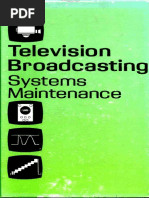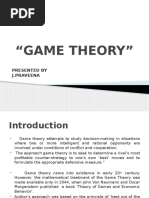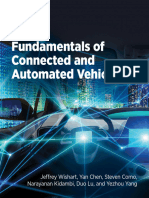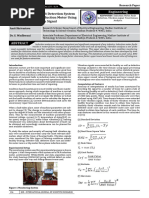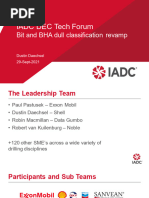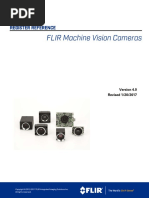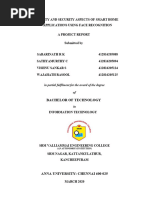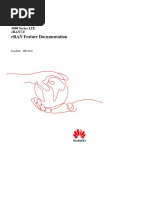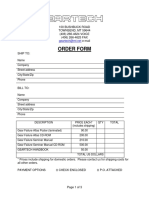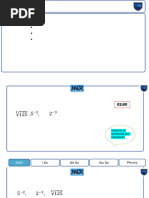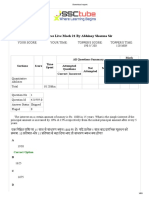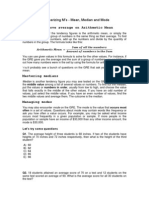Vibration Analysis: Principles of
Vibration Analysis: Principles of
Uploaded by
jeyaselvanmCopyright:
Available Formats
Vibration Analysis: Principles of
Vibration Analysis: Principles of
Uploaded by
jeyaselvanmOriginal Title
Copyright
Available Formats
Share this document
Did you find this document useful?
Is this content inappropriate?
Copyright:
Available Formats
Vibration Analysis: Principles of
Vibration Analysis: Principles of
Uploaded by
jeyaselvanmCopyright:
Available Formats
Principles of
Vibration Analysis
with Applications in
Automotive Engineering
VibrationAnalysis_txt.indb i 11/24/10 11:43:29 AM
Other Related Publications Available from SAE International:
Vehicle Refinement
By Matthew Harrison
(Product Code: R-364)
Vehicle Vibration and Sound
By Gang Sheng
(Product Code: R-400)
Car Suspension and Handling, Fourth Edition
By Geoffrey Howard
(Product Code R-318)
For more information or to order a book, contact SAE International at
400 Commonwealth Drive, Warrendale, PA 15096-0001 USA;
phone 877-606-7323 (U.S. and Canada only) or 724-776-4970 (outside U.S.
and Canada);
fax (724) 776-0790;
e-mail CustomerService@sae.org;
website http://books.sae.org.
VibrationAnalysis_txt.indb ii 11/24/10 11:43:32 AM
Principles of
Vibration Analysis
with Applications in
Automotive Engineering
C. Q. Liu and
Ronald L. Huston
Warrendale, Pennsylvania
USA
VibrationAnalysis_txt.indb iii 11/24/10 11:43:32 AM
400 Commonwealth Drive
Warrendale, PA 15096-0001 USA
E-mail: CustomerService@sae.org
Phone: 877-606-7323 (inside USA and Canada)
724-776-4970 (outside USA)
Fax: 724-776-1615
Copyright © 2011 SAE International. All rights reserved.
No part of this publication may be reproduced, stored in a retrieval system,
distributed, or transmitted, in any form or by any means without the prior
written permission of SAE. For permission and licensing requests, contact
SAE Permissions, 400 Commonwealth Drive, Warrendale, PA 15096-0001
USA; e-mail: copyright@sae.org; phone: 724-772-4028; fax: 724-772-9765.
ISBN 978-0-7680-3339-7
Library of Congress Catalog Number 2010940965
SAE Order No. R-395
Information contained in this work has been obtained by SAE International
from sources believed to be reliable. However, neither SAE International
nor its authors guarantee the accuracy or completeness of any information
published herein and neither SAE International nor its authors shall be
responsible for any errors, omissions, or damages arising out of use of
this information. This work is published with the understanding that
SAE International and its authors are supplying information, but are not
attempting to render engineering or other professional services. If such
services are required, the assistance of an appropriate professional should be
sought.
To purchase bulk quantities, please contact:
SAE Customer Service
E-mail: CustomerService@sae.org
Phone: 877-606-7323 (inside USA and Canada) 724-776-4970 (outside USA)
Fax: 724-776-1615
Visit the SAE Bookstore at
http://store.sae.org
iv
VibrationAnalysis_txt.indb iv 11/24/10 11:43:32 AM
Contents
Preface xiii
Chapter One Introduction 1
1.1 What Is Vibration? 1
1.2 Classification of Vibration Studies 2
(1) Vibration Analysis 2
(2) System Design 2
(3) Input Evaluation 2
(4) System Identification 2
1.3 Classification of Vibration 3
(1) Classification Based on Input 3
(2) Classification Based on Output 4
(3) Classification Based on the Degrees of Freedom
of the System 7
(4) Classification Based on Differential Equation
of Motion of the System 7
1.4 Harmonic Vibration 8
1.5 Harmonic Analysis 10
Problems 16
References 18
Chapter Two Vibration of a Single-Degree-of-Freedom System 21
2.1 Introduction: Modeling 21
2.2 Free Vibration of a Single-Degree-of-Freedom System 24
(1) Governing Differential Equation of Motion 24
(2) Equivalent Spring Stiffness 28
2.3 The Energy Method 33
(1) The Law of Conservation of Energy 33
(2) The Rayleigh Method 34
2.4 Effective Mass 40
2.5 Damped Free Vibration of a Single-Degree-of-Freedom System 41
(1) Damping Forces 41
(2) Differential Equation of Motion 41
(3) Discussion of the Solution 43
Problems 50
References 53
v
VibrationAnalysis_txt.indb v 11/24/10 11:43:33 AM
Chapter Three Harmonically Excited Motion 55
3.1 Introduction 55
3.2 Forced Harmonic Vibration of Damped Systems 55
3.3 Forced Harmonic Vibration of Undamped Systems 63
(1) Beating 64
(2) Resonance 66
3.4 Forced Vibration Caused by Rotating Unbalance 67
3.5 Forced Vibration Caused by Support Motion 69
3.6 Vibration Isolation 72
(1) Isolation of the Machine from the Foundation 73
(2) Isolation of the Foundation from the Machine 73
3.7 Damping 76
(1) Energy Dissipation Due to a Viscous Damping Force 76
(2) Structural (Hysteretic) Damping 78
(3) Complex Stiffness and Lost Factor 79
(4) Sharpness of Resonance 80
3.8 Forced Vibration Under Periodic Excitation 81
3.9 Response to Arbitrary Excitation 82
Problems 87
References 92
Chapter Four Balancing of Rotors 93
4.1 Unbalance 93
(1) Static Unbalance 93
(2) Dynamic Unbalance 94
4.2 Whirling of Rotating Shaft 95
4.3 Experimental Balancing 98
(1) The Influence Coefficient Method: Single-Plane Balancing 98
(2) The Influence Coefficient Method: Two-Plane Balancing 100
4.4 Inertia Forces in a Single-Cylinder Engine 104
4.5 Inertia Forces and Couples of Multicylinder Engines 110
4.6 Balancing of Crankshafts 120
Problems 126
References 133
vi
VibrationAnalysis_txt.indb vi 11/24/10 11:43:33 AM
Chapter Five Multi-Degree-of-Freedom Systems 137
5.1 Introduction 137
5.2 Two-Degree-of-Freedom Systems 137
(1) Equations of Motion 137
(2) Characteristic Equation and Natural Frequency 138
(3) Mode Shapes 138
5.3 Eigenvalues and Eigenvectors 140
5.4 Orthogonal Properties of the Modal Vectors 143
5.5 Zero Eigenvalues and Repeated Roots 146
(1) Zero Eigenvalues 146
(2) Repeated Roots 147
5.6 Response of a System to Initial Conditions 150
5.7 Coordinate Coupling 152
5.8 Undamped Systems and Coordinate Decoupling 155
(1) Forced Response and Coordinate Decoupling 155
(2) Initial Value Problem and Coordinate Decoupling 157
5.9 Damped Systems and Coordinate Decoupling 159
(1) Coordinate Decoupling with Forced Response 159
(2) Coordinate Decoupling with Initial Value Problems 162
5.10 Lagrange’s Equations 164
(1) Generalized Coordinates and Virtual Displacements 165
(2) Virtual Work and Generalized Forces 165
(3) Lagrange’s Equations 166
5.11 Kane’s Equations 169
(1) Partial Velocities and Partial Angular Velocities 170
(2) Inertia Forces 170
(3) Generalized Applied Forces 172
(4) Kane’s Equations 172
Problems 174
References 177
Chapter Six Numerical Methods 179
6.1 Introduction 179
6.2 Various Eigenvalue Analyses 179
(1) The Generalized Eigenvalue Problem 179
(2) The Algebraic Eigenvalue Problem 180
vii
VibrationAnalysis_txt.indb vii 11/24/10 11:43:33 AM
(3) The Symmetric Eigenvalue Problem 180
(4) The Standard Eigenvalue Problem in State Space 183
(5) The Generalized Eigenvalue Problem in State Space 185
6.3 Numerical Evaluation of the Time Response 197
Problems 210
References 214
Chapter Seven Transfer Functions and Frequency
Response Functions 217
7.1 Introduction 217
7.2 The Laplace Transformation and Fourier Transformation 217
(1) The Laplace Transform 217
(2) The Fourier Transform 219
7.3 Laplace Domain: Transfer Function 220
7.4 Frequency Domain: Frequency Response Function 223
(1) Receptance (or Admittance, or Dynamic Compliance) 223
(2) Mobility 223
(3) Accelerance (or Inertance) 223
(4) The Bode Diagrams 226
(5) The Nyquist Diagrams 228
7.5 Time Domain: Impulse Response Function 230
7.6 FRFs of Multi-Degree-of-Freedom Systems 234
(1) Laplace Domain: Transfer Function Matrix 235
(2) Frequency Domain: Frequency Response Function Matrix 238
(3) Time Domain: Impulse Response Functions 241
7.7 Determination of Residues and Poles in State Space 248
Problems 254
References 257
Chapter Eight Lumped Parameter Systems 259
8.1 Introduction 259
8.2 The Flexibility and Stiffness Matrices 259
8.3 Maxwell’s Reciprocity Theorem 261
8.4 Eigenvalue Analysis 265
8.5 Dunkerley’s Equation 269
8.6 Rayleigh Principle 271
8.7 Method of Matrix Iteration 274
8.8 Determining of Higher-Order Modes and Frequencies 277
viii
VibrationAnalysis_txt.indb viii 11/24/10 11:43:33 AM
8.9 Transfer Matrix Method 279
(1) A Spring-Mass System 280
(2) Torsional Systems 286
(3) A Geared System 289
(4) Branched Systems 290
8.10 Beams Modeled as Lumped Masses 292
(1) Flexural Vibration 292
(2) Rotating Beams 301
Problems 304
References 308
Chapter Nine Continuous Systems 309
9.1 Introduction 309
9.2 Lateral Vibration of a String 310
(1) d’Alembert’s Solution 310
(2) Separation of Variables 312
9.3 Longitudinal Vibration of Rods 315
9.4 Torsional Vibration of Rods 320
9.5. Lateral Vibration of Beams 323
9.6 Orthogonal Relations 331
9.7 Effects of Rotary Inertia, Shear, and Axial Loading 336
(1) The Effect of Rotary Inertia and Shearing Deformation 336
(2) The Effect of Axial Force on Lateral Vibration 339
9.8 Forced Vibration 340
9.9 Ritz Method 344
Problems 348
References 351
Chapter Ten Engine Mounting Systems 353
10.1 Introduction 353
10.2 Inertia Properties of an Engine 354
(1) Reference Frame and Direction Cosines 358
(2) Inertia Matrix 358
(3) Mass Center 361
10.3 Orientation Angles and Transformation Matrix 363
10.4 Equations of Motion 372
(1) Forces and Torques Produced by an Engine Mount
due to Translational Motion of the Engine 374
ix
VibrationAnalysis_txt.indb ix 11/24/10 11:43:33 AM
(2) Forces and Torques Produced by an Engine Mount
due to Rotational Motion of the Engine 376
10.5 Mode Shapes and Natural Frequencies 379
10.6 Decoupling and Optimization 382
(1) Two-Degree-of-Freedom Coupled System 384
(2) Three-Degree-of-Freedom Coupled System 387
(3) Optimization 389
10.7 Torque Roll Axis (TRA) 395
10.8 Torque Roll Axis (TRA) Mode Decoupling 397
Problems 398
References 402
Chapter Eleven Experimental Modal Analysis 405
11.1 Introduction 405
11.2 Modal Analysis Theory 406
11.3 The Complex Exponential Algorithm 408
11.4 The Least-Squares Complex Exponential Method 412
11.5 The Polyreference Time Domain Method 412
11.6 The Ibrahim Time Domain Method 419
11.7 The Eigensystem Realization Algorithm 422
11.8 Estimation of Modal Vectors 426
11.9 Estimation of Frequency Response Functions 428
(1) Ĥ1 Estimator of FRF 430
(2) Ĥ2 Estimator of FRF 431
(3) Ĥv Estimator of FRF 432
11.10 Coherence Function 433
(1) Ordinary Coherence Function 433
(2) Multiple Coherence Function 434
(3) Partial Coherence Function 435
11.11 Discrete Fourier Transfer (DFT)
and Fast Fourier Transfer (FFT) 436
(1) Aliasing 438
(2) Leakage 438
11.12 Window Functions 440
11.13 Averaging 442
(1) Linear Average 443
(2) Stable Average 443
VibrationAnalysis_txt.indb x 11/24/10 11:43:34 AM
11.14 Overlapping Signal Analysis 443
11.15 Modal Data Acquisition 444
(1) Test Structure 445
(2) Exciter 447
(3) Data Acquisition System 451
(4) Analyzer 453
11.16 Operational Modal Analysis 453
(1) Stochastic Subspace Identification Method 454
(2) The Natural Excitation Technique (NExT) 457
11.17 Running Modes Analysis 458
Problems 460
References 463
Chapter Twelve Special Topics 467
12.1 Introduction 467
12.2 Complex Structure Analysis Using the FRFs of Substructures 467
(1) Equations of Motion 468
(2) Solution Method 469
12.3 Translational Vibration Absorber 475
(1) Absorber Tuning Based on the Primary System FRF 476
(2) Special Cases: A Single-Degree-of-Freedom System 480
12.4 Torsional Vibration Absorber 486
12.5 Experimental Measurement of the Torsional FRF 487
12.6 HYFEX Method 488
12.7 Sensitivity Analysis 495
(1) Eigenvalue Derivatives 496
(2) Eigenvector Derivatives 497
References 503
Appendix A 507
Appendix B 509
Appendix C 513
Notation 519
Index 537
xi
VibrationAnalysis_txt.indb xi 11/24/10 11:43:34 AM
VibrationAnalysis_txt.indb xii 11/24/10 11:43:34 AM
Preface
Over the years there have been many outstanding books written on
vibrations, including textbooks, books on analysis and design, and theoretical
treatises. Why then should there be another, and, specifically, why this book?
There are several reasons: First, vibrations, as with all science and engineering
subjects, is continually evolving. As new discoveries and new analyses and
new experimental procedures are developed, there is an ongoing need to
document these advances.
Next, with the evolution in the subject, many of the older procedures
become obsolete. Traditional topical emphases become less important, and
are superseded by advances in computational and measurement methods.
Consequently, new topical emphases are emerging. There is a need to
document these new methods for students and for practicing engineers.
Finally, it is always helpful to have a state-of-the-art treatise on fundamentals
enabling future research and application.
We wrote this book attempting to satisfy each of these needs. The book
summarizes basic concepts and established analytical methodologies.
We then illustrate these ideas and procedures via worked-out examples.
Numerous examples using Matlab are presented throughout the text. The
various chapters contain problems (with answers) for readers studying the
subject for the first time, and for those seeking additional expertise and/
or review. In the later chapters, we illustrate application in automotive
engineering with a focus upon engine balancing and engine mounting
systems. Finally, the book is intended to be a quick reference for current
(circa 2010) modeling and analysis methods.
The book is divided into twelve chapters, with the first of these providing an
introduction to vibration terminology. In the second chapter we review the
fundamentals of single-degree-of-freedom systems, and in the third chapter
we consider harmonically excited motion.
The fourth chapter applies these concepts with rotors, outlining balancing
methods.
In the fifth chapter we study multi-degree-of-freedom systems, and then we
devote a chapter to numerical methods. In the seventh chapter we introduce
the concept of transfer functions and frequency response functions together
with a detailed discussion about these functions.
Chapter eight explores lumped parameter modeling and chapter nine follows
with analyses of continuous systems.
Chapter ten provides an extensive exposition of engine mounting systems.
xiii
VibrationAnalysis_txt.indb xiii 11/24/10 11:43:34 AM
Chapter eleven summarizes experimental modal analysis methods, including
the basic theory and an account of signal processing and test procedures.
In the final chapter, we conclude with some special topics, such as the
frequency response function (FRF)-based substructure method, the hybrid
finite element and experimental (HYFEX) method, system sensitivity
analysis, and vibration absorber tuning.
Prior to writing this book we were fortunate to have studied under
and been associated with academicians and engineers in industry who
have significantly advanced the state of the art through their research,
development, application, and exposition of both theoretical and
experimental breakthroughs. We are particularly appreciative of the
inspiration provided by the innovations of faculty (David L. Brown and
Randall J. Allemang) and students at the Structural Dynamics Research
Laboratory (SDRL) at the University of Cincinnati, and of engineers in local
industries, and particularly in the automotive industry. We have relied heavily
upon these sources for our exposition.
We have also, of course, relied upon many others, as cited in the references
and permissions. We have attempted to acknowledge all sources, but
undoubtedly have missed many which should have been cited. We apologize
for any such omissions.
A number of the examples in this book have originated with the references
listed in the chapters. Although we attempt to acknowledge these sources, the
examples are not direct quotations. Instead they are usually done differently
and often more extensively than in the quoted sources.
We appreciate the assistance of Charlotte Better in preparing the manuscript.
We also appreciate the assistance of Aaron Lock in preparing the artwork for
this book.
Finally, we are grateful to the Society of Automotive Engineers (SAE) for their
interest and their acceptance of our work.
C. Q. Liu
Ronald L. Huston
xiv
VibrationAnalysis_txt.indb xiv 11/24/10 11:43:35 AM
You might also like
- MATH1179 Text Book Part 1 2021-2022Document78 pagesMATH1179 Text Book Part 1 2021-2022Oviyan100% (1)
- Television Broadcasting Systems Maintenance EnnesDocument510 pagesTelevision Broadcasting Systems Maintenance EnnesFredji82No ratings yet
- Decentralized E-Voting System Based On BlockchainDocument89 pagesDecentralized E-Voting System Based On Blockchainviswa100% (3)
- Arku LevelingDocument20 pagesArku Levelingjeyaselvanm50% (2)
- Handbook of Experimental Structural Dynamics - Peter Avitable - Randall Allemag - 2017Document7 pagesHandbook of Experimental Structural Dynamics - Peter Avitable - Randall Allemag - 2017jeyaselvanmNo ratings yet
- Game TheoryDocument12 pagesGame Theorypraveena50% (2)
- 541 39 Solutions-Instructor-manual Chapter 2Document7 pages541 39 Solutions-Instructor-manual Chapter 2Carey JohnNo ratings yet
- Special-Relativity (2003) by N M J WoodhouseDocument203 pagesSpecial-Relativity (2003) by N M J WoodhouseSafi Ahmed100% (3)
- RIA 자료Document23 pagesRIA 자료sports981112No ratings yet
- Fundamentals of Connected and Automated VehiclesDocument273 pagesFundamentals of Connected and Automated VehiclesvrajakisoriDasiNo ratings yet
- Project ReportDocument94 pagesProject Reportalok patelNo ratings yet
- ISO 18436 Category IV Vibration Analyst Training TopicsDocument1 pageISO 18436 Category IV Vibration Analyst Training TopicsDean LofallNo ratings yet
- SORN SIMATRANG Fault Detection For Rolling Element Bearings Using Model-Based TechniqueDocument154 pagesSORN SIMATRANG Fault Detection For Rolling Element Bearings Using Model-Based Techniquesatyaveetr singhNo ratings yet
- Viva Slide ExampleDocument18 pagesViva Slide ExampleIntan Nurfarahin AhmadNo ratings yet
- Iso 1155 1978Document4 pagesIso 1155 1978Chibao VoNo ratings yet
- Areospace Fluid Comp Designers HDBK Volume IIDocument754 pagesAreospace Fluid Comp Designers HDBK Volume IIchris_moellers8060No ratings yet
- A Motor Primer - Part 5Document13 pagesA Motor Primer - Part 5Gia Hien Nguyen TanNo ratings yet
- Rolling Bearing Diagnosing Method Based On Empirical Mode Decomposition of Machine Vibration SignalDocument9 pagesRolling Bearing Diagnosing Method Based On Empirical Mode Decomposition of Machine Vibration SignalMarcos RamisNo ratings yet
- Bearing_Fault_Detection_and_Diagnosis_Using_Case_WDocument26 pagesBearing_Fault_Detection_and_Diagnosis_Using_Case_WAhmed GHORBELNo ratings yet
- Rosemount 3051: F Fieldbus Reference CardDocument2 pagesRosemount 3051: F Fieldbus Reference CardEduardo Landa GonzalezNo ratings yet
- (Ebeling, 1997) Accuracy of Response of Single-Degree-ofFreedom Systems To Ground MotionDocument92 pages(Ebeling, 1997) Accuracy of Response of Single-Degree-ofFreedom Systems To Ground MotionLeon Valencia RestrepoNo ratings yet
- Rotating Blade Faults Classification of A Rotor-Disk-Blade System Using Artificial Neural NetworkDocument12 pagesRotating Blade Faults Classification of A Rotor-Disk-Blade System Using Artificial Neural NetworkInternational Journal of Power Electronics and Drive SystemsNo ratings yet
- Full download Vehicle Accident Analysis and Reconstruction Methods 3rd Edition R. Matthew Brach pdf docxDocument40 pagesFull download Vehicle Accident Analysis and Reconstruction Methods 3rd Edition R. Matthew Brach pdf docxmegretalondo100% (5)
- 2013 Development of Fault Detection System For Ball Bearing of Induction Motor Using Vibration SignalDocument4 pages2013 Development of Fault Detection System For Ball Bearing of Induction Motor Using Vibration SignalRevathi SudalaimaniNo ratings yet
- Basic Automotive Test Products CatalogDocument19 pagesBasic Automotive Test Products CatalogMarian VerdeNo ratings yet
- Instant ebooks textbook 3D Scanning for Advanced Manufacturing, Design, and Construction: Metrology for Advanced Manufacturing Gary C. Confalone download all chaptersDocument66 pagesInstant ebooks textbook 3D Scanning for Advanced Manufacturing, Design, and Construction: Metrology for Advanced Manufacturing Gary C. Confalone download all chaptersbezweckt100% (5)
- Rolling Element Bearing Methodology Application Guide - 164934 PDFDocument36 pagesRolling Element Bearing Methodology Application Guide - 164934 PDFAbdoEmanuelMalverdiNo ratings yet
- 7100 Series 101Document67 pages7100 Series 101Plutarca BenavidesNo ratings yet
- (FREE PDF Sample) Pedestrian Inertial Navigation With Self-Contained Aiding (IEEE Press Series On Sensors) 1st Edition Andrei M. Shkel EbooksDocument79 pages(FREE PDF Sample) Pedestrian Inertial Navigation With Self-Contained Aiding (IEEE Press Series On Sensors) 1st Edition Andrei M. Shkel Ebooksnaiirjao100% (1)
- FCC SAR Test Report For Quark 2+ TB PDFDocument24 pagesFCC SAR Test Report For Quark 2+ TB PDFjoaopedromartins.lifeNo ratings yet
- UntitledDocument226 pagesUntitledb.makesan0% (1)
- 3500 - Proximitor and Seismic MonitorDocument41 pages3500 - Proximitor and Seismic Monitortestvsptest100% (1)
- PowerDistributionNetworkDesignForVLSI PDFDocument211 pagesPowerDistributionNetworkDesignForVLSI PDFshoryaveer -No ratings yet
- Power System Protection 2nd Edition Henville Charles Rifaat Rasheek Kennedy William Johnson Brian download pdfDocument40 pagesPower System Protection 2nd Edition Henville Charles Rifaat Rasheek Kennedy William Johnson Brian download pdfubrajhoilon46100% (6)
- Fault Classification by SVMDocument15 pagesFault Classification by SVMSagar AnsaryNo ratings yet
- 12 Types of Bearing DefectsDocument5 pages12 Types of Bearing Defectsjameel babooramNo ratings yet
- 10465-Article Text-71953-1-10-20211005Document14 pages10465-Article Text-71953-1-10-20211005babourimohamedkhemissiNo ratings yet
- Matrix Approach To Perform Dependent Failure Analysis in Compliance With Functional Safety StandardsDocument6 pagesMatrix Approach To Perform Dependent Failure Analysis in Compliance With Functional Safety StandardsDuewee87No ratings yet
- DECQ321_Dustin_DaechselDocument27 pagesDECQ321_Dustin_DaechselLeonardo do Amaral SilvaNo ratings yet
- Technical Guide To LTE Throughput DT Data-Based Accurate Network OptimizationDocument62 pagesTechnical Guide To LTE Throughput DT Data-Based Accurate Network OptimizationBassem Abouamer100% (1)
- Where can buy A Networking Approach to Grid Computing 1st Edition Daniel Minoli ebook with cheap priceDocument61 pagesWhere can buy A Networking Approach to Grid Computing 1st Edition Daniel Minoli ebook with cheap pricefunmyelsethNo ratings yet
- A Two Stage Estimation Method Based On Conceptors Aided Unsup 2023 Expert SyDocument17 pagesA Two Stage Estimation Method Based On Conceptors Aided Unsup 2023 Expert Sy刘蔚南No ratings yet
- Moring Failure Detection PDFDocument58 pagesMoring Failure Detection PDFkhaleedsyedNo ratings yet
- Good ReportDocument62 pagesGood ReportRahul ganesha GaneshaNo ratings yet
- Closed-Loop Step Motor Control Using Absolute Encoders: Use Would Not Infringe Privately Owned Rights. ReferDocument16 pagesClosed-Loop Step Motor Control Using Absolute Encoders: Use Would Not Infringe Privately Owned Rights. ReferGoran MiljkovicNo ratings yet
- 13310Document50 pages13310stohrservejlNo ratings yet
- Assessment of Gearbox Fault DetectionUsi PDFDocument9 pagesAssessment of Gearbox Fault DetectionUsi PDFAekDzLaiNo ratings yet
- FLIR Machine Vision Camera Register ReferenceDocument103 pagesFLIR Machine Vision Camera Register ReferenceParus LilianNo ratings yet
- Submitted byDocument71 pagesSubmitted byLê Trung DũngNo ratings yet
- Basic Iris M Version2.3 PDFDocument109 pagesBasic Iris M Version2.3 PDFMuhammad Fahmi MahmudNo ratings yet
- 20PW111 ThesisDocument82 pages20PW111 ThesisRocking SivaNo ratings yet
- HP-DSA Aplication Note 243-1Document42 pagesHP-DSA Aplication Note 243-1Andres Felipe Loaiza PatiñoNo ratings yet
- Mri Devices Corporation: Technical ReportDocument9 pagesMri Devices Corporation: Technical ReportRogerio CastroNo ratings yet
- Finger VeinDocument71 pagesFinger VeinAfza FathimaNo ratings yet
- ZTE eRAN 7.0Document59 pagesZTE eRAN 7.0hailukalkidan651No ratings yet
- BTP Final 2019Document67 pagesBTP Final 2019Himanshu MeenaNo ratings yet
- PRACHDocument41 pagesPRACHmonem777No ratings yet
- Software Defined Radio 2002Document350 pagesSoftware Defined Radio 2002khadimthiamNo ratings yet
- Dialnet-AnalysisModelingAndSimulationSolutionOfInduceddraf-9572461Document14 pagesDialnet-AnalysisModelingAndSimulationSolutionOfInduceddraf-9572461adugnayaddooNo ratings yet
- Full Download Attribute-based Encryption (ABE): Foundations and Applications within Blockchain and Cloud Environments Jianbin Gao PDF DOCXDocument47 pagesFull Download Attribute-based Encryption (ABE): Foundations and Applications within Blockchain and Cloud Environments Jianbin Gao PDF DOCXomskykakara100% (4)
- VLC Based Health Care Monitoring System in Hospital Using LIFIDocument48 pagesVLC Based Health Care Monitoring System in Hospital Using LIFIAkshayasree KannanNo ratings yet
- Nouvelle Version 2023 en VDDocument80 pagesNouvelle Version 2023 en VDPP043No ratings yet
- BJA24002 - RoboREC標準仕様書 - 英文 - 第1版Document9 pagesBJA24002 - RoboREC標準仕様書 - 英文 - 第1版anhkysuvndnNo ratings yet
- CSE35 Project ReportDocument111 pagesCSE35 Project ReportSrinadh ReddyNo ratings yet
- Instant Download Introduction to Autonomous Mobile Robots 1st Edition Roland Siegwart PDF All ChaptersDocument50 pagesInstant Download Introduction to Autonomous Mobile Robots 1st Edition Roland Siegwart PDF All Chapterskekuaskimer2100% (2)
- SIAT - First Announcement 2021 - Final PDFDocument4 pagesSIAT - First Announcement 2021 - Final PDFjeyaselvanmNo ratings yet
- Aircraft Interior Acoustics BasicsDocument12 pagesAircraft Interior Acoustics BasicsjeyaselvanmNo ratings yet
- MSC Science of SoundDocument1 pageMSC Science of SoundjeyaselvanmNo ratings yet
- SIAT - First Announcement 2021 - Final PDFDocument4 pagesSIAT - First Announcement 2021 - Final PDFjeyaselvanmNo ratings yet
- STC Brochure AVE 2015Document2 pagesSTC Brochure AVE 2015jeyaselvanmNo ratings yet
- The Story of Allan D. Pierce Jerry H. GinsbergDocument7 pagesThe Story of Allan D. Pierce Jerry H. GinsbergjeyaselvanmNo ratings yet
- TVC Input Data Form Page 7Document17 pagesTVC Input Data Form Page 7jeyaselvanmNo ratings yet
- Helling Katalog NDTDocument43 pagesHelling Katalog NDTjeyaselvanmNo ratings yet
- Top 8 Vibration Analysis Software PackagesDocument7 pagesTop 8 Vibration Analysis Software PackagesjeyaselvanmNo ratings yet
- State-Space Representation of A Plant Plant With State-Variable FeedbackDocument1 pageState-Space Representation of A Plant Plant With State-Variable FeedbackjeyaselvanmNo ratings yet
- The Story of Allan D. Pierce Jerry H. GinsbergDocument7 pagesThe Story of Allan D. Pierce Jerry H. GinsbergjeyaselvanmNo ratings yet
- 950 3-3 P5ZR 30 Pag 650-100Document8 pages950 3-3 P5ZR 30 Pag 650-100jeyaselvanmNo ratings yet
- IDS - Optimized For VibrationDocument4 pagesIDS - Optimized For VibrationjeyaselvanmNo ratings yet
- Small Dimensions With Huge PotentialDocument5 pagesSmall Dimensions With Huge PotentialjeyaselvanmNo ratings yet
- Geartech ProductsDocument3 pagesGeartech ProductsjeyaselvanmNo ratings yet
- Flow Acoustics - KTH - FlowAc - Info PDFDocument1 pageFlow Acoustics - KTH - FlowAc - Info PDFjeyaselvanmNo ratings yet
- Two Phase IsentropyDocument7 pagesTwo Phase IsentropyjeyaselvanmNo ratings yet
- Signal Processing in PhysicalDocument18 pagesSignal Processing in PhysicaljeyaselvanmNo ratings yet
- Y9 Indices Standard Form 2Document22 pagesY9 Indices Standard Form 2n.h.cr7edittzzNo ratings yet
- Combining Like Terms: NotesDocument6 pagesCombining Like Terms: NotesGiovanni ToussaintNo ratings yet
- Lindenstrauss, Tzafriri - Classical Banach Spaces I - Sequence Spaces - (1977)Document202 pagesLindenstrauss, Tzafriri - Classical Banach Spaces I - Sequence Spaces - (1977)Bui Ngoc MuoiNo ratings yet
- Ctanujit Classes of Mathematics Statistics & Economics: MSQMS 2015 Solution Paper QMA (Mathematics)Document14 pagesCtanujit Classes of Mathematics Statistics & Economics: MSQMS 2015 Solution Paper QMA (Mathematics)Shayan Sen GuptaNo ratings yet
- ASME - IsO GD&T Standard DifferencesDocument1 pageASME - IsO GD&T Standard Differencesravi7447100% (1)
- 11 ProbDocument2 pages11 Probachandra100% (1)
- Surds PagesDocument3 pagesSurds PagesAKRISHNAMURTY,HEADMASTER,ZPHS(G),DOWLESWARAMNo ratings yet
- Random-Number Generation: Discrete-Event System SimulationDocument32 pagesRandom-Number Generation: Discrete-Event System SimulationAreeba AshrafNo ratings yet
- Class 6 Mathematics WorksheetDocument11 pagesClass 6 Mathematics WorksheetNECHUZZ ZONENo ratings yet
- Salzburg Seminar TalkDocument15 pagesSalzburg Seminar TalkRogelio CarreraNo ratings yet
- Monday 14 January 2019: Further Pure Mathematics F1Document32 pagesMonday 14 January 2019: Further Pure Mathematics F1wissam riyasNo ratings yet
- CPP - Quadratic Equation - V - 1Document3 pagesCPP - Quadratic Equation - V - 1sourav tapadarNo ratings yet
- Class 10 HHDocument1 pageClass 10 HHAnsh YadavNo ratings yet
- 13 Kings Scholarship Maths A Paper 2014 Eton CollegeDocument6 pages13 Kings Scholarship Maths A Paper 2014 Eton CollegeakashNo ratings yet
- Cambridge International General Certificate of Secondary EducationDocument20 pagesCambridge International General Certificate of Secondary EducationFahad FayyazNo ratings yet
- Mock 21 Abhinay Sharma SirDocument93 pagesMock 21 Abhinay Sharma Sirjituuuuu12345No ratings yet
- Centripetal Force: Formula Sources Analysis of Several CasesDocument17 pagesCentripetal Force: Formula Sources Analysis of Several CasesFredNo ratings yet
- Dampack AnalysisDocument45 pagesDampack Analysisratno widoyoNo ratings yet
- Lesson 15: Solution Sets of Two or More Equations (Or Inequalities) Joined by "And" or "Or"Document10 pagesLesson 15: Solution Sets of Two or More Equations (Or Inequalities) Joined by "And" or "Or"drecosh-1No ratings yet
- UNIT - 1: Disjoint SETS: Equivalence RelationsDocument11 pagesUNIT - 1: Disjoint SETS: Equivalence RelationsGuna ShekarNo ratings yet
- 368 Truth Table Abbreviated Cheat SheetDocument2 pages368 Truth Table Abbreviated Cheat SheetLauren PickNo ratings yet
- CIR CalibrationDocument8 pagesCIR CalibrationNicolas Lefevre-LaumonierNo ratings yet
- MODULE 2 Mathematical Language and Symbols Week 3 To Week 4Document12 pagesMODULE 2 Mathematical Language and Symbols Week 3 To Week 4Ariane Leslie CambaNo ratings yet
- GRE AverageDocument23 pagesGRE AverageperwinsharmaNo ratings yet

